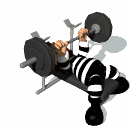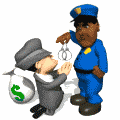|
In our country, only the U.S. Treasury Department can print money or make coins. Every other bill or coin made by someone else is "counterfeit" money. Counterfeit means fake.
 People who make fake money are called counterfeiters and can be sent to jail for as long as fifteen years. People who make fake money are called counterfeiters and can be sent to jail for as long as fifteen years.
In the first years of our country, banks could print money. By 1860, the United States had 1600 banks, printing over 7000 different kinds of legal bills. Lots of people began to make fake money because no one could keep track of what all these different kinds of money looked like. Soon about one in every three dollars was counterfeit.
In 1860 Congress passed a law that only the U.S. government could print money. All paper money is printed at the Bureau of Engraving and Printing in Washington, D.C. That’s where postage stamps are printed, too.
 On July 5, 1865, the government started the "Secret Service," whose mission was to catch counterfeiters and send them to jail. Today the Secret Service is better known for guarding the President, but they still track down counterfeiters, too. On July 5, 1865, the government started the "Secret Service," whose mission was to catch counterfeiters and send them to jail. Today the Secret Service is better known for guarding the President, but they still track down counterfeiters, too.
|
The invention of computers and copy machines has made things worse, and counterfeiting is a crime on the rise.  For example, only 37 people were arrested in 1995 for counterfeiting, but in 2002 there were 4500. Just one Secret Service office in Los Angeles collects about $400,000 in counterfeit bills every month. For example, only 37 people were arrested in 1995 for counterfeiting, but in 2002 there were 4500. Just one Secret Service office in Los Angeles collects about $400,000 in counterfeit bills every month.
Stores, credit unions and banks help the Secret Service by finding fake money. They use machines that look like little flashlights that give out ultraviolet (UV) rays. By shining UV rays on each bill, little polymer threads in the paper will glow. Five-dollar bills have blue threads; $10 have orange; $20 have green; $50 have yellow and $100 have red ones.
 The most commonly counterfeited bill is the $20 bill. The U.S. Treasury’s Bureau of Engraving and Printing began printing a $20 bill in 2003 with green, peach and blue colors in the background, along with other changes that make counterfeiting more difficult. To view a cool interactive bill that demonstrates the anti-counterfeiting features, click here. The most commonly counterfeited bill is the $20 bill. The U.S. Treasury’s Bureau of Engraving and Printing began printing a $20 bill in 2003 with green, peach and blue colors in the background, along with other changes that make counterfeiting more difficult. To view a cool interactive bill that demonstrates the anti-counterfeiting features, click here.
If you try to buy something with a counterfeit bill or deposit one into your bank account, the store, credit union or bank has the right to keep that bill and not pay you for it. You could even be held for questioning by the police.
|